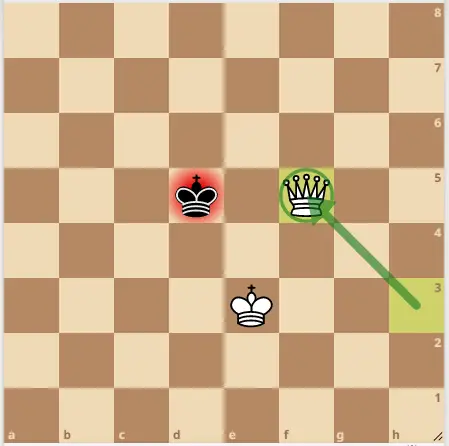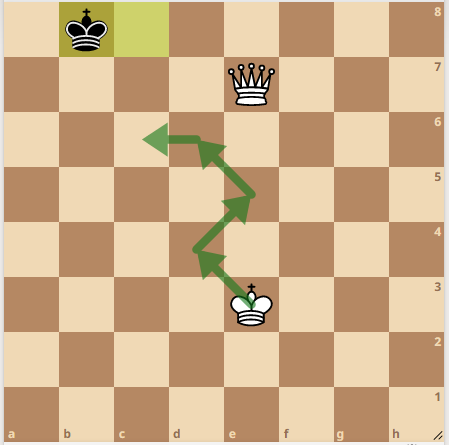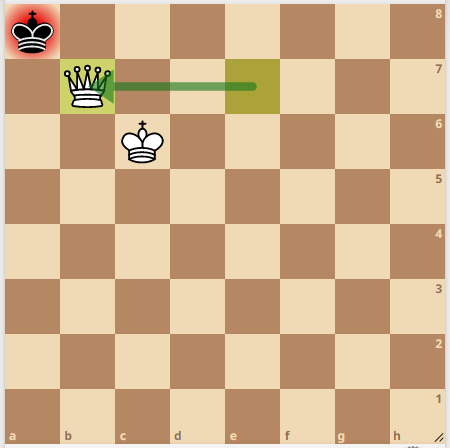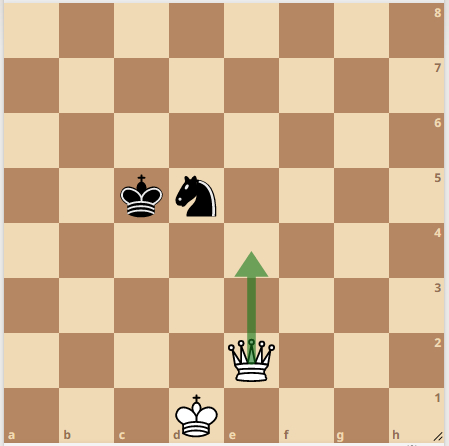The queen is the most powerful piece on the chess board. It moves any number of squares in any direction in a straight line. In other words, the queen can move diagonally, up, down or sideways.
The queen usually has enough force to checkmate the opposing king. However, the queen cannot do this alone. In order to win chess with a queen, it would need to be coupled with another piece such as a king, rook, knight or bishop.
In this article, we will explain how to win the chess game with only your queen and king left. The strategy is actually straightforward, so be sure to follow along.
How To Win Chess With Only Queen And King?
It’s the endgame. You’ve managed to capture all your opponent’s pieces off the board and all he has left is his bare king. Meanwhile, you only have your queen and king left on the board. So how do you checkmate your opponent?
To checkmate your opponent with only a queen, you will need to perform what is known as “shrinking the box” technique. It’s a strategy where you use your queen to entrap the enemy king into a box. You slowly work your queen down the ranks or files until the king gets trapped on any of the 4 edges of the board. Once you get to this stage, with the help of your king, the queen delivers the final blow.
Let’s see how this works over the board.
Step #1: Force the king away from the central squares
The first step to winning chess with only a queen and king is to force the enemy king away from the central squares. The main central squares on a chess board are e4, d4, e5, and d5. It’s next to impossible to checkmate the enemy king in the center of the board. As a result, you will need to use your queen to chase the king away from the center when performing this technique.
In the following position, the black king is in the center. If white wants to checkmate the black king with the queen, the black king would need to be chased from the center of the board to any of the 4 edges of the chess board. White can start by giving check to the black king via Qf5.

Step #2: Form an imaginary box
The box method may not be the quickest way to win chess with the queen, but it’s very effective in faster time control formats where you are down to seconds on the clock and you don’t have time to think.
The idea is to draw an imaginary box that prevents the king from going outside of this box. Because the queen is a long ranged piece, it cuts the king off from gaining access to squares outside of this boundary.
The black king is trapped inside the box as indicated by the green markings

As you can see, the white queen is cutting off the black king. It would be illegal for the black king to step over this boundary onto squares such as b5, c5, or d5. This endangers the king as the white queen would capture it on the next move.
Step #3: Shrink The Box Using Your Queen
Now that you got the king away from the center and you have trapped it inside of the box, the next step is to slowly shrink the box until the king is forced to go to the edge of the board.
In the position below, white can shrink the box by moving the queen to e5.
Shrinking the box

After a move like Kd7, white can continue to shrink the box by moving the queen to f6. The black king is now one rank away from being on the edge of the board.

Continue this technique until the king is cornered on either edge of the board. The game belows shows how white was able to get the king to the backrank (edge of the board). Click through the game to the see the moves leading up this position.
Step #4: March Your King Over
Once you’ve got the enemy king on the edge of the board, it’s now time to march your king over to the action so that you can deliver checkmate. The queen alone cannot deliver checkmate. Therefore, you need to get your king involved.
March your king towards the enemy king.

Step #5: Deliver The Final Blow (Checkmate)

Now that you’ve got the enemy king cornered and your king has marched up the board, it’s now time to deliver checkmate. Here, white can checkmate the black king with the move Qb7#
The white queen checkmates the black king

There you have it, the 5 steps to win chess with only a queen and king. The strategy is to slowly shrink the box until the enemy king is cornered on either edge of the board. Then, with the help of your king, the queen can deliver the final blow to the enemy king.
Avoiding Stalemate
While checkmating with a king and queen is a straightforward strategy, you may stalemate the game if you are not careful.
Stalemate in chess is when a player has no legal moves left in the position. When this happens, the game ends in a draw.
The difference between checkmate and stalemate is that checkmate happens when you’ve attacked your opponent’s king but he has no legal moves to escape the check. Stalemate is when the king is NOT under attack but has no legal moves to make.
Stalemate is very common in king and queen endgames, especially when there is limited time on the clock. This even happens to strong players as well. It’s not because they don’t know any better. It’s because they are not paying attention.
Going back to our previous position. If white is not careful and plays Qc7, the game would immediately end in stalemate. White wastes his opportunity to win the game.

After Qc7, the black king has no legal squares to move to. The black king cannot step onto an endangered square (a7, b7, b8). Therefore, the game is drawn by stalemate.
Stalemate

When Your Opponent Has A Bishop Or Knight On The Board
You can still checkmate the opposing king with your king and queen even if your opponent has a minor piece on the chess board.
For example, in king and knight vs king and queen endgame, the queen can deliver checkmate to the enemy king as long as you watch out for potential knight forks in the position.
The knight is a very tricky piece and a formidable opponent. Even with a whole queen on the board, you still can fall into the knight’s trap if you don’t pay attention.
The strategy remains the same, “shrink the box and get the opposing king to any of the 4 edges of the chess board”.
In the following position, the white queen can run into a knight fork if he carelessly plays the move Qe4:
Qe4 is an attempt to create the box. But this is a huge mistake.

The black knight forks the king and queen with the move Knight c3.

After the black knight captures the white queen on e4, the game ends in a draw by insufficient material. (A king and knight alone cannot deliver checkmate). White would have wasted the game.
King and Bishop vs King and Queen
King and bishop vs king and queen checkmate is a lot easier than king and knight vs king and queen checkmate. The bishop is not as tricky as the knight. It cannot pounce about like an octopus forking multiple pieces at the same time.
Just watch out for potential skewers or pins in the position. A skewer is an attack on 2 pieces that are lined up with one another, sharing the same file or diagonal. The first piece is the more valuable piece. When it moves out of the way, the less valuable piece behind it is captured. A pin on the other hand is when a piece is held in place and cannot move without giving up a more valuable piece behind it.
For example, in the position below, the black bishop can pin the white queen to the king with the move Bishop d6. This wins the queen on the next move, thereby drawing the game.
White should watch out for the move Bishop d6 which would pin the queen.

Final Verdict
With the help of the king, you can easily win the chess game with only a queen. The main strategy is to create a box for the enemy king and slowly shrink it until the king is forced to any of the 4 edge of the chess board.
When you’ve achieved this, move your king close to where the enemy king is. Then use your queen to deliver the final blow.
When shrinking the box, make sure that you don’t stalemate your opponent as you’ll end up wasting the game.
Post you may like: 15 Must know chess tactics for beginners


